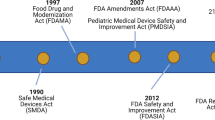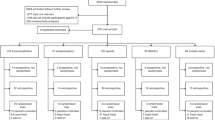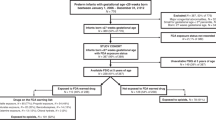Abstract
Approximately 1.5 million neonates receive general anesthesia each year for a surgical procedure. Despite this being an essential practice, a number of recent studies now indicate that anesthetic exposure could cause toxicity and neuronal apoptosis in the developing brain. This could potentially influence long-term neurodevelopmental outcome, especially premature infants in need of multiple surgical procedures. Most anesthetic drugs routinely administered to neonates have not been adequately tested for safety or efficacy. Given the number of confounders, dosing is often extrapolated from adults. This is concerning since many different drugs can be administered concurrently, with few of these agents actually approved for use by the Food and Drug Administration. Since 1997, legislation has been passed in the United States and abroad encouraging more drug investigation in infants and children. This has resulted in over 500 labeling changes to products regarding safety and efficacy in various pediatric age groups. However, only three drugs routinely used as anesthetic agents in newborn infants have had any updated labeling (none in very premature infants). This “off-label” use without adequate testing must be addressed. Therefore, more clinical trials of common anesthetic agents used alone and in combination in neonates are urgently needed.
Similar content being viewed by others
Log in or create a free account to read this content
Gain free access to this article, as well as selected content from this journal and more on nature.com
or
References
Hoppu K, Anabwani G, Garcia-Bournissen F, et al. The status of paediatric medicines initiatives around the world–What has happened and what has not? Eur J Clin Pharmacol 2012;68:1–10.
US Food and Drug Administration. New pediatric labeling information database, 2014. http://www.accessdata.fda.gov/scripts/sda/sdNavigation.cfm?sd=labelingdatabase.
Rodriguez W, Selen A, Avant D, et al. Improving pediatric dosing through pediatric initiatives: what we have learned. Pediatrics 2008;121:530–9.
US Food and Drug Administration. Pediatric study plan, 2013. http://www.fda.gov/downloads/drugs/guidancecomplianceregulatoryinformation/guidances/ucm360507.pdf.
Turner MA, Catapano M, Hirschfeld S, Giaquinto C ; Global Research in Paediatrics. Paediatric drug development: the impact of evolving regulations. Adv Drug Deliv Rev 2014;73:2–13.
Institute of Medicine of the National Academies. Preterm birth: causes, consequences, and prevention, 2006. http://www.iom.edu/Reports/2006/Preterm-birth-Causes-Consequences-and-Prevention.aspx.
Shah PS, Sankaran K, Aziz K, et al.; Canadian Neonatal Network. Outcomes of preterm infants <29 weeks gestation over 10-year period in Canada: a cause for concern? J Perinatol 2012;32:132–8.
Horbar JD, Carpenter JH, Badger GJ, et al. Mortality and neonatal morbidity among infants 501 to 1500 grams from 2000 to 2009. Pediatrics 2012;129:1019–26.
Laughon MM, Avant D, Tripathi N, et al. Drug labeling and exposure in neonates. JAMA Pediatr 2014;168:130–6.
US Government Accountability Office. Pediatric Research: products studied under two related laws, but improved tracking needed by FDA, 2011. http://www.gao.gov/assets/320/319073.pdf.
Davis JM, Connor EM, Wood AJ. The need for rigorous evidence on medication use in preterm infants: is it time for a neonatal rule? JAMA 2012;308:1435–6.
Carlo WA, Finer NN, Walsh MC, et al. Target ranges of oxygen saturation in extremely preterm infants. N Engl J Med 2010;362:1959–69.
Finer NN, Carlo WA, Walsh MC, et al. Early CPAP versus surfactant in extremely preterm infants. N Engl J Med 2010;362:1970–9.
Hudson KL, Guttmacher AE, Collins FS. In support of SUPPORT–a view from the NIH. N Engl J Med 2013;368:2349–51.
Benjamin DK Jr, Smith PB, Murphy MD, et al. Peer-reviewed publication of clinical trials completed for pediatric exclusivity. JAMA 2006;296:1266–73.
Dunne J, Rodriguez WJ, Murphy MD, et al. Extrapolation of adult data and other data in pediatric drug-development programs. Pediatrics 2011;128:e1242–9.
Benjamin DK Jr, Smith PB, Sun MJ, et al. Safety and transparency of pediatric drug trials. Arch Pediatr Adolesc Med 2009;163:1080–6.
Mellon RD, Simone AF, Rappaport BA. Use of anesthetic agents in neonates and young children. Anesth Analg 2007;104:509–20.
Roberts R, Rodriguez W, Murphy D, Crescenzi T. Pediatric drug labeling: improving the safety and efficacy of pediatric therapies. JAMA 2003;290:905–11.
Zheng H, Dong Y, Xu Z, et al. Sevoflurane anesthesia in pregnant mice induces neurotoxicity in fetal and offspring mice. Anesthesiology 2013;118:516–26.
Taddio A, Ohlsson A. Intravenous midazolam infusion for sedation of infants in the neonatal intensive care unit. Cochrane Data Syst Rev 2012;6:CD002052.
Welzing L, Roth B. Experience with remifentanil in neonates and infants. Drugs 2006;66:1339–50.
Welzing L, Kribs A, Huenseler C, Eifinger F, Mehler K, Roth B. Remifentanil for INSURE in preterm infants: a pilot study for evaluation of efficacy and safety aspects. Acta Paediatr 2009;98:1416–20.
Ancora G, Lago P, Garetti E, et al. Efficacy and safety of continuous infusion of fentanyl for pain control in preterm newborns on mechanical ventilation. J Pediatr 2013;163:645–51.e1.
Hall RW, Kronsberg SS, Barton BA, Kaiser JR, Anand KJ ; NEOPAIN Trial Investigators Group. Morphine, hypotension, and adverse outcomes among preterm neonates: who’s to blame? Secondary results from the NEOPAIN trial. Pediatrics 2005;115:1351–9.
Norman E, Wikström S, Rosén I, Fellman V, Hellström-Westas L. Premedication for intubation with morphine causes prolonged depression of electrocortical background activity in preterm infants. Pediatr Res 2013;73:87–94.
de Graaf J, van Lingen RA, Valkenburg AJ, et al. Does neonatal morphine use affect neuropsychological outcomes at 8 to 9 years of age? Pain 2013;154:449–58.
Chrysostomou C, Schulman SR, Herrera Castellanos M, et al. A phase II/III, multicenter, safety, efficacy, and pharmacokinetic study of dexmedetomidine in preterm and term neonates. J Pediatr 2014;164:276–82.e1–3.
Ramsay JG, Rappaport BA. SmartTots: a multidisciplinary effort to determine anesthetic safety in young children. Anesth Analg 2011;113:963–4.
Sun L. Early childhood general anaesthesia exposure and neurocognitive development. Br J Anaesth 2010;105:Suppl 1:i61–8.
Morriss FH Jr, Saha S, Bell EF, et al.; Eunice Kennedy Shriver National Institute of Child Health and Human Development Neonatal Research Network. Surgery and neurodevelopmental outcome of very low-birth-weight infants. JAMA Pediatr 2014;168:746–54.
Williams R, Pfister R, Black I. The neonatologist’s role in pediatric anesthesia neurotoxicity. JAMA Pediatr 2014;168:701–3.
Baer GR, Nelson RM ; Ethics Group of the Newborn Drug Development Initiative. Ethical challenges in neonatal research: Summary report of the ethics group of the newborn drug development initiative. Clin Ther 2006;28:1399–407.
Hoehn KS, Nathan A, White LE, et al. Parental perception of time and decision-making in neonatal research. J Perinatol 2009;29:508–11.
Kasai S, Ikeda K. Pharmacogenomics of the human µ-opioid receptor. Pharmacogenomics 2011;12:1305–20.
Anand KJ, Aranda JV, Berde CB, et al. Analgesia and anesthesia for neonates: study design and ethical issues. Clin Ther 2005;27:814–43.
Wachman EM, Hayes MJ, Brown MS, et al. Association of OPRM1 and COMT single-nucleotide polymorphisms with hospital length of stay and treatment of neonatal abstinence syndrome. JAMA 2013;309:1821–7.
Davis PJ, Galinkin J, McGowan FX, et al. A randomized multicenter study of remifentanil compared with halothane in neonates and infants undergoing pyloromyotomy. I. Emergence and recovery profiles. Anesth Analg 2001;93:1380–6, table of contents.
Galinkin JL, Davis PJ, McGowan FX, et al. A randomized multicenter study of remifentanil compared with halothane in neonates and infants undergoing pyloromyotomy. II. Perioperative breathing patterns in neonates and infants with pyloric stenosis. Anesth Analg 2001;93:1387–92, table of contents.
Russell IA, Miller Hance WC, Gregory G, et al. The safety and efficacy of sevoflurane anesthesia in infants and children with congenital heart disease. Anesth Analg 2001;92:1152–8.
Acknowledgements
The authors acknowledge and thank Robert “Skip” Nelson, MD PhD (Deputy Director and Senior Pediatric Ethicist, Office of Pediatric Therapeutics, Food and Drug Administration) for his input and advice. Dr. Davis is Chair of the Neonatal Advisory Committee, Office of Pediatric Therapeutics, FDA.
Author information
Authors and Affiliations
Corresponding author
Rights and permissions
About this article
Cite this article
Nasr, V., Davis, J. Anesthetic use in newborn infants: the urgent need for rigorous evaluation. Pediatr Res 78, 2–6 (2015). https://doi.org/10.1038/pr.2015.58
Received:
Accepted:
Published:
Issue date:
DOI: https://doi.org/10.1038/pr.2015.58
This article is cited by
-
Is it time for a time-out? Progress versus politics in studying the psychosexual implications of penile circumcision
International Journal of Impotence Research (2023)
-
Safety profile of anesthetic modalities during laser treatment for retinopathy of prematurity: a systematic review
Journal of Perinatology (2023)
-
Assessing and conveying risks and benefits of imaging in neonates using ionizing radiation and sedation/anesthesia
Pediatric Radiology (2022)
-
Trends of genetic changes uncovered by Env- and Eigen-GWAS in wheat and barley
Theoretical and Applied Genetics (2022)
-
Epidemiology of abdominal wall and groin hernia repairs in children
Pediatric Surgery International (2021)



